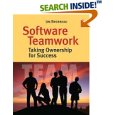Next Software Frontier: Software Testing
I blogged about what are the three big things to me that are the next Software Frontier. They are Usability, Software Testing, and Virtualization. I touched Usability, let's move on to Software Testing:
The higher bar on usability and quality is one part of QA challenge. The other part is testing productivity, which is falling far behind the development productivity. Over a decade, development tools improved significantly, allowing programmers to crank out massive software. The complexity grows exponentially, and so does the demand for testing. But the testing productivity today only grows linearly by throw more bodies, or brains, if you’re lucky to find them. Demand is high, but supply of skilled and motivated testers are short.
The industry is still looking for answers. Time is one: wait till generation of monkey testers will pass away and a new generation of trained passionate and well-paid test engineers will come to replace them. Those who don’t have patience are looking at improving the quality in the Dev part of the house. Speaking strongly: if developers make more crap then the testers can handle, why don’t they just stop shitting and clean up? Do some [unit]testing? Go for code coverage? Take up test automation? Yeah, more quality in, more quality out. But here we often face resistance. Some old programmers habits have to die may be only with their owners.
The last one, Virtualization, is not that obvious. Stay tuned, I will come to it in the next post.


